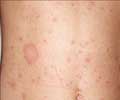Exposure to direct UV sunlight during sunbathing in summer, increases the risk of skin cancer later in life, is a known fact.

The researchers describe the skin cancer probe in a new paper published in the journal Review of Scientific Instruments, from AIP Publishing.
Skin cancers of all types are the most common forms of cancer in North America, and melanoma, the most deadly form of skin cancer, is one of the leading causes of cancer death, killing nearly 10,000 people every year in the United States.
Currently, the only definitive way to diagnose skin cancer is to perform a biopsy, in which doctors remove a suspect skin lesion and then examine the stained tissue under a microscope to look for cancerous cells. Determining which lesions to biopsy is an imprecise art, however, and for every case of skin cancer detected there are roughly 25 negative biopsies performed, translating to a cost of $6 billion to the U.S. health care system, according to estimations performed by the researchers.
James Tunnell, an associate professor in the biomedical engineering department at UT, believes the new probe developed by his team could eventually help reduce the high number and cost of negative biopsies by giving a clear picture of which skin lesions are most likely cancerous. He and his colleagues combined three common spectroscopic techniques – Raman spectroscopy, diffuse reflectance spectroscopy, and laser-induced fluorescence spectroscopy – into one probe to create a more complete picture of a skin lesion. By revealing information invisible to the human eye, the probe could offer a better screening tool for cancer and eliminate many negative biopsies.
As normal skin becomes cancerous, cell nuclei enlarge, the top layers of skin can thicken and the skin cells can increase their consumption of oxygen and become disorganized, Tunnell said. The changes alter the way light interacts with the tissue.
Advertisement
Previous research efforts have tried combining spectroscopic techniques to aid in skin cancer detection, but the University of Texas team is the first to combine three techniques in a single probe that would be inexpensive enough to be used widely in clinics and doctors' offices. The probe itself is about the size of a pen and the spectroscopic and computer equipment that supports it fits neatly onto a portable utility cart that can be wheeled between rooms. Each reading takes about 4.5 seconds to perform. The 3-in-1 nature of the probe saves time and money while still giving a comprehensive examination of the skin properties.
Advertisement















